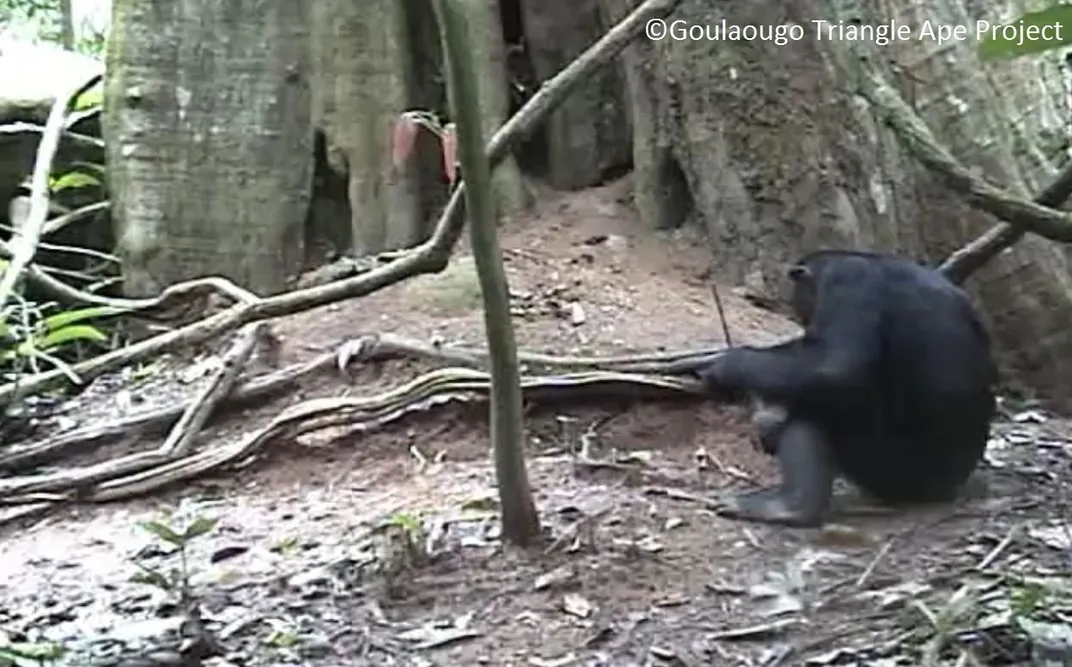Chimpanzees’ Termite Fishing Habits Differ by Regional Groups
Some scientists say the finding is an ‘absolute milestone in culture in nature research’
/https://tf-cmsv2-smithsonianmag-media.s3.amazonaws.com/filer/bc/5f/bc5fc062-e772-4aa8-9695-0c554ada146d/chimpanzees_1.jpg)
Scientists have long understood that chimpanzees lead complex social lives. The primates engage in warfare, have complicated social relationships and experience something akin to mourning.
Many researchers argue that these kinds of inherited local traditions among chimpanzees constitute chimpanzee “culture,” reports Rowan Hooper for New Scientist. In a study published this week in Nature Human Behavior, one team of researchers hope to provide further evidence for chimp culture—and, crucially, cultural diversity—by analyzing another key behavior: their snacking habits.
Led by Christophe Boesch at the Max Planck Institute for Evolutionary Anthropology, researchers analyzed chimpanzee’s “termite fishing” habits across the African continent, according to a statement. Chimpanzees hunt for the nutrient-rich insects by poking sticks inside holes in termite mounds, pulling the stick out with bugs attached and scooping the insects into their mouths. When famed primatologist Jane Goodall first recorded this behavior in chimpanzees nearly 60 years ago, it was the first time an animal besides humans had been recorded using a tool, as Sarah Zielinski reported for Smithsonian magazine in 2010.
Researchers working with the Pan African Programme used remotely operated cameras to study chimps in ten geographically distant communities on the African continent, Bob Yirka reports for Phys.org. Scientists had previously identified only two groups of termite fishers: those who fish in aboveground termite nests, and those who fish in underground ones. After studying the communities, scientists identified 38 technical elements to termite fishing—and found that many chimpanzee groups fish very differently from their neighbors.

“The diversity of techniques seen in chimpanzee termite fishing was a huge surprise to me. Not only does each community have a very unique way of fishing, they also combine a number of different elements into specific termite fishing etiquettes,” Boesch says in a statement.
For instance, the Wonga Wongué chimpanzees in Gabon lie down on their sides to probe the mounds for insects. The Korup chimpanzees in southwest Cameroon lean on their elbows to fish, while Goualougo chimps in the Republic of Congo sit down while fishing, according to the study.
The differences in fishing go beyond just posture: “In La Belgique in Cameroon, chimpanzees fashion their stick by opening the fibers to obtain a long brush and then rest the termite-covered stick on their wrist while they eat. On the other hand, at another site in Cameroon called Korup, the chimpanzees do not make a brush at all and use their mouth to shake the inserted stick while it is in the mound,” Boesch continues.
Most of the chimpanzee studied live in similar habitats with access to similar resources, which means that scientists can rule out environmental constraints to account for these differences, according to the statement.
Rather, termite fishing etiquette seem to differ with each regional group. Individuals in each group shared more termite fishing techniques when compared with chimps from other groups.
“This supports the idea that chimpanzees are capable of imitating social techniques in ‘how to termite fish’ which goes beyond alternative explanations such as each individual reinventing termite fishing each time they learn it,” co-author Ammie Kalan says in statement.
“This paper is an absolute milestone in ‘culture in nature’ research,” Carel van Schaik, a primatologist at the University of Zurich not involved in the study, tells the New Scientist.
Yet as more research continues to be done on the subject of animal cultures, chimp culture might be at risk. As Brigit Katz reported for Smithsonian magazine in 2019, another study by Pan African Programme researchers found that chimpanzee culture was disappearing in the face of human disruption, including habitat destruction, road building, poaching and logging. Chimps living near areas of “high degree of human impact” were 88 percent less likely to display a diversity of social behaviors than chimps residing in regions with the lowest degree of human impact.
“We’re still investigating it,” Kalan, who was also involved in the 2019 study, told Ed Yong of The Atlantic at the time. “And we might be running out of time.”
/https://tf-cmsv2-smithsonianmag-media.s3.amazonaws.com/accounts/headshot/nora.png)


/https://tf-cmsv2-smithsonianmag-media.s3.amazonaws.com/accounts/headshot/nora.png)